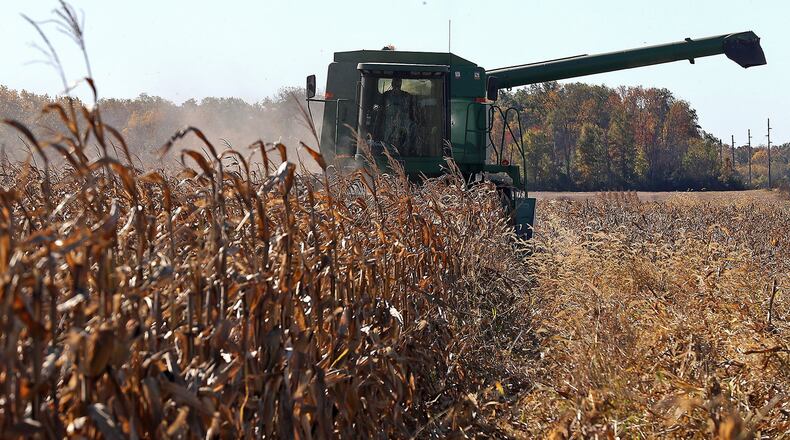“There’s a lot of desperation right now,” said Champaign County farmer Tom Nisonger, who is also the county’s Farm Bureau president. “We just couldn’t get the crops in the field…yields aren’t what they should be; we’re still fighting the tariffs. We don’t know what the future is. That’s serious.”
Nisonger’s county was one of three locally that the USDA said are primary natural disaster designations because of the excessive rains and flooding in the first nine months of this year.
Champaign, Clark and Miami counties were added to a growing list of designated primary natural disaster areas, which means farmers in those counties can apply for government disaster loans. Fourteen Ohio counties received the designation Friday, according to USDA, adding to the seven that were placed on the list earlier this year.
»RELATED: Farms relying on federal payments more
“Every field we have been in has at least had spots where the crop didn’t grow or water ponded up and drowned it out,” said Clark County farmer Brian Harbage.
As harvest has gone on, yields have gotten worse with the later planted crops, Harbage said. He’s seeing soybean yields nearly half the usual and corn yields down about 25% in an extremely variable year, he said.
In Darke County, soybean yields have ranged between 20 and 65 bushels per acre while corn has been as low as 70 and as high as 255, said Sam Custer, agriculture educator in Darke County. Nisonger said his corn field was pulling 120 bushels per acre when two miles west his son’s field averaged 180.
“There’s a lot of variability,” said Amanda Douridas, Champaign County’s Ohio State Extension agriculture educator. “There are farmers who of course didn’t get anything planted at all and are dealing with receiving maybe 50% of what they normally would from insurance versus planting a crop or having really low yields because they were in an area that got flooded out continuously.”
Meanwhile farmers are also struggling with fluctuating prices, unsure of when and how much to sell, Harbage and Green County farmer Darren Reed said.
»BIZ BEAT: Stores offer deals earlier to attract holiday shoppers
“I’ve got to play the games with the markets to get the best money I can out of my crop,” Reed said. “It’s been kind of difficult. (The price) will go up and then it will drop and then it will go up again. And some days it will hold steady…It all just depends on how bad they’re wanting corn and beans.”
Farmers like Darren, Harbage and Nisonger are eligible to apply for USDA emergency loans because of the primary and secondary disaster designations in their counties.
The designation also helps farmers pass some of the tedious steps in applying for emergency relief programs offered by the USDA, said Leonard Hubert, Executive Director of the Ohio Farm Service Agency. Producers in designated counties have automatically surpassed the hurdle of proving that their damage happened during a major disaster.
Champaign, Clark, Miami, Adams, Belmont, Guernsey, Highland, Madison, Monroe, Noble, Portage, Stark, Summit, Trumbull, Butler, Hamilton, Knox, Warren, Defiance, Fayette and Logan counties are among the primary disaster areas because of excessive rain and flooding ranging from October 2018 through September.
The contiguous counties designated as secondary natural disaster areas include Montgomery, Darke, Greene, Ashtabula, Brown, Carroll, Clinton, Columbiana, Coshocton, Cuyahoga, Fayette, Franklin, Geauga, Harrison, Holmes, Jefferson, Logan, Mahoning, Medina, Morgan, Muskingum, Pickaway, Pike, Ross, Scioto, Shelby, Tuscarawas, Union, Washington and Wayne.
»BIZ BEAT: JCPenney’s new store format includes fitness classes, smart dressing rooms
Farmers are eligible only if they suffered a 30% loss in crop production or a physical loss of livestock, livestock products and real estate, according to a statement from the USDA. Farmers must also have acceptable credit history, and be unable to get credit from commercial sources. Collateral is required.
Interest rates change, but are currently at 3.5%, which is typically low, Hubert said.
“That’s a great tool for them to use to secure low interest rate loans to help in the grain marketing process,” Custer said. “They can use that money to make their payments while they attempt to market their grain at a better price.”
The deadline to apply is June 3, 2020. The Farm Services Administration will review the loans based on the extent of losses, security available and repayment ability, according to the statement.
“These programs are not designed to make anybody whole and they’re certainly not going to make up for some of the lost income and some of the downturns in the farm economy,” said Jack Irvin, senior director of state and national policy for the Ohio Farm Bureau. “But the goal of most of these type of programs are simply to help be a tool and bridge the gap between today and hopefully a brighter day down the road.
FIVE FAST READS
• Here’s the Thanksgiving and Black Friday hours for 2 dozen area stores
• Needmore Kroger closing comes at ‘vulnerable time’ following tornadoes
• Average airfare at Dayton airport among top five most expensive
• Kohl’s drops Black Friday sales ad and $15 Kohl’s Cash deal
• Popular Dayton sports complex makes a comeback following tornado
By the numbers
1.5M: Acres unplanted in Ohio
3.5%: Emergency loan interest rate
14: Ohio counties with primary natural disaster designation
About the Author
